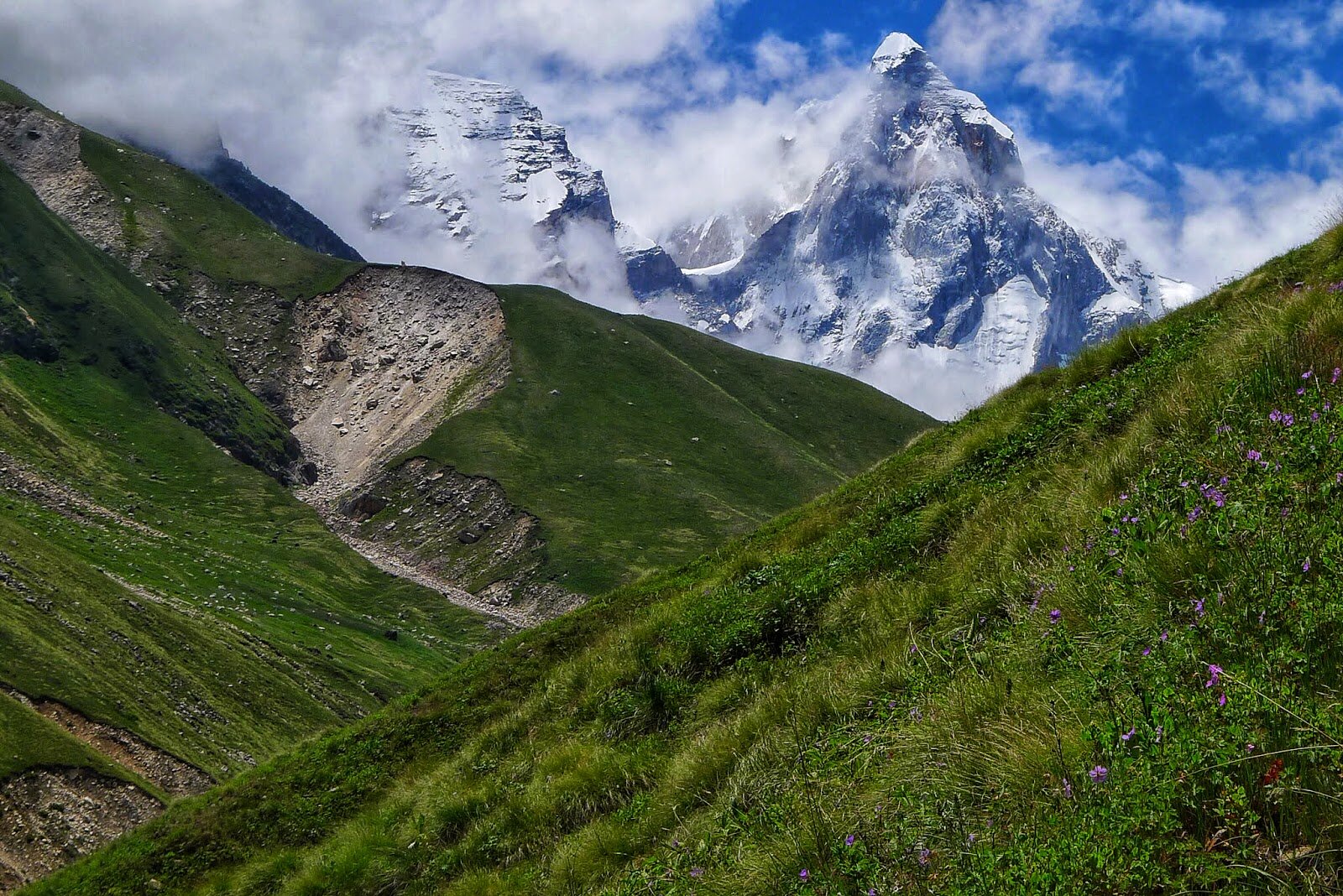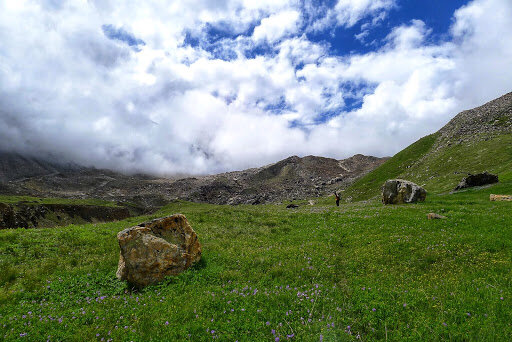Pardesi Pahadi: Kedar Tal - Finding magic in the Himalaya
Broken stones blanket the Kedar Glacier - Photo: Zachary Conrad
‘That night I knew that there was magic left in this world’ – On a trek to Kedar Tal, Zachary Conrad faced danger, awe, and unmatched beauty.
Author’s Note: The Himalayas are my favorite mountain range. I know that must sound obvious and banal, like being a Yankees fan, or being really into the Beatles. But they’re more than just the tallest mountains in the world. For the seven years that I lived in Landour, Mussoorie, these mountains were a constant presence, a beckoning horizon I could always look up to, and disappear to whenever I had the chance. These trips into the Himalayas were the best part of my life in India and how I connected with its people and its culture. These mountains are like nowhere on Earth, and I hope to share them with you.
Ajit and I paused to roll our pants up all the way over our knees before stepping into the roiling current of the Kedar Ganga. We needed to ensure that we reduced any chance of dislodging a rock as we picked our way through the landslide. At first, we could hear the percussive clap of rocks crashing down and reverberating through the mountain valley; now, only the voice of the river remained, splashing around our ankles and soaking our pants.
Ajit shouted over the roar of the river, “Come quickly!”, and reached out his had to me.
Ajit considering the river. Photo: Zachary Conrad
I was afraid. I breathed twice in an effort to stay calm and braced myself against the current, taking short steps on the hidden river bottom. I took Ajit’s hand and clambered onto a slippery boulder. The spray of the river continued to soak us as we hopped carefully from one slippery boulder to the next, stealing quick glances upward to watch for falling rocks we could not hear.
Navigating loose stones at that angle would be difficult and dangerous; if one of us slipped, we would probably pinball all the way to the river below. The best option was to move quickly and carefully through the bottom of the slide. Don't stop. Don't kick stones.
A few more hops, and we were back to the shore, but still not on solid ground. Time stretched out as we picked our way over loose boulders and jagged stones, ever-attentive that our footfall not dislodge any stone.
A landslide, and especially a fresh one, is an unstable jumble of rocks and other debris. A shifting stone lower down can upset the balance, bringing down larger stones from above. This volatility is greater on steeper inclines and newer slides. Often, time and gravity work to sort things out: the vulnerable stones fall, and an equilibrium is reached with the biggest boulders near the bottom and smaller stones at the top. At more time passes, seeds take root in the gaps, their roots break the rock, and the remains break down, begetting more soil and more plants. These act like a glue holding the rocks in place. So, a landslide with plants growing in it is generally stable. It’s the kind of landslide you don’t mind ahead of you.
That wasn't what Ajit and I were facing on our way up to Kedar Tal. The powerful river at the bottom of this landslide continually eroded its base, and precluded this progression toward stability. The melting and freezing of the cooler months, and rains during monsoon, keep throwing rocks to the river which carries them off. Erosion in the Himalaya happens faster than anywhere else on earth.
Bhriguanth and Thaley Sagar from the meadows below. Photo: Zachary Conrad
When facing an unstable landslide, a prudent option is to travel near its crest. There, any rocks that fall will fall below you.
But this isn't always a viable option. The top of this landslide was a good 120 metres above, and flanked by rocky cliffs. It was steep too, up to 40 degrees in certain places. Navigating loose stones at that angle would be difficult and dangerous; if one of us slipped, we would probably pinball all the way to the river below. The best option was to move quickly and carefully through the bottom of the slide. Don't stop. Don't kick stones.
Watching the clouds from camp. Photo: Zachary Conrad
A few more minutes of careful movement brought us back to safer ground. We sat in the grass and squeezed the water out of our socks. Ajit hadn't seemed vexed as we entered the landslide, but he was visibly relieved to be on the other side.
I first met Ajit about a year prior on a school organized trek. He was working as our porter, and had an obvious enthusiasm for the mountains. A few months later, we met again inadvertently at Gaumukh, the snout of the Gangotri Glacier. Ajit had been working as a porter for a few years, and taken a mountaineering course with the Nehru Institute of Mountaineering (NIM) in Uttarkashi. So, when it came time for me to plan this trek to Kedar Tal, I didn’t want to take on such a high and demanding task solo; I asked Ajit to accompany me.
We met at the Uttarkashi bus stand on an oppressively hot and muggy day in July. We bought sabzi on our way along the noisy street to the Gangotri jeep stand, where we waited for ten other passengers to squeeze in, our shirts wet with sweat. Eventually the jeep filled, and we started our slow climb up the ravine carved by the Bhagirathi River cutting through the mountains.
A rampart of broken boulders seemed the safest way to proceed - Photo: Zachary Conrad
I've always liked this drive: the river roaring below you, and the mountains impossibly tall above. The ravine widens at Suki, offering an impressive view of the river. By Harsil, the main thrust of the Himalaya are behind you. It's less humid, and, owing to the altitude, cooler, too. The canyon again narrows as you cross the towering Lanka Bridge and make your way to Gangotri, nestled among granite spires, deodar forest, and mist on the banks of the Bhagirathi. We made our way through the narrow street thronged with yatris to the usual guest house, and marveled at the river, swollen and the colour of chocolate milk, quaking as it rushed above the highest steps of the ghats, nearly jumping its banks.
Due to the altitude, we planned to spend another full day and night in Gangotri before continuing upwards. Acclimatization is very important. Most trekkers and mountaineers experience mild AMS (acute mountain sickness) symptoms in the Himalaya. Usually, it’s not a big deal, but when improperly acclimatized, this condition can progress to more severe AMS, high-altitude pulmonary edema or high-altitude cerebral edema. These can kill. The only effective treatment is rapid decent, which is always inconvenient and could be dangerous or impossible given the terrain and the size/skill of your party.
Photo: Zachary Conrad
So, we took it easy at Gangotri, collected our permits from the forest service, drank chai, and hiked around in our chappals. The next morning, Ajit used Feviquik to glue the soles back onto a pair of boots that a previous trekker had abandoned. Then, we made our way up, winding through the trees and mist, high up the sheer walls of the Kedar Ganga gorge. We reached a meadow just past Boj Karakh in the afternoon and made an early camp.
My middling Hindi and Ajit’s limited English made conversation difficult. We drank chai and played simple card games like ‘War’, but mostly, we sat in silence watching the clouds shift and swirl as afternoon gave way to evening, then night. When the rain began falling in soft sheets we retired to the tent. It was wet the next morning as we made our way through the grasses and wild flowers to the landslides above.
A quick scramble over a large mound of talus brought our objective—Kedar Tal—into view. The lake glowed a milky aquamarine under a clouded sky with the snow-clad flanks of Bhrigupanth and Thaley Sagar just visible above. Mist enveloped us and we were trapped in a landscape both harsh and serene.
Mountains, and especially the Himalaya, are always more than we can handle. We have to be careful when we go out to greet them at our own level. It's important to balance ambition with caution. The more you go out, the more adept you become at reading the landscape, gleaning what might go wrong, how likely that ‘wrong’ could be, and what to do if it does. You also start to see that there are options, choices you could make to reduce the likelihood of a mishap, or lessen the consequences if things do go awry. You get to know yourself better too: what are your skills, how you handle pressure, your tolerance for risk.
Too often, I get stuck in my head, imagining every possible mistake I could make, instead of focusing on the most-likely outcome. I'd rather be old than bold, but I am learning bit by bit to trust myself and trust my abilities, knowing which fears to listen to and which to tune out.
If you stay alert in the mountains you can always choose to keep going, to go back, or to change your path. Having a partner you can trust helps, too. We couldn't talk about it in great detail, but I knew Ajit would refuse to do something he thought was too difficult or too risky. A favorite saying among guides and porters in the Himalaya is “Jabardasti mat karo.” Don't force it. I was a bit out of my comfort zone, but I trusted Ajit.
Further ahead the meadow flattened again into a small grazing ground called Kedar Kharak. The boulders and rubble marking the terminal moraine of the Kedar Bamak glacier were just ahead. Our route snaked around boulders and over clear, fast-flowing streams. Child's play compared to our earlier difficulties.
Thaley Sagar reflected in the clear water at Kedar Tal. Photo: Zachary Conra
A quick scramble over a large mound of talus brought our objective—Kedar Tal—into view. The lake glowed a milky aquamarine under a clouded sky with the snow-clad flanks of Bhrigupanth and Thaley Sagar just visible above. Mist enveloped us and we were trapped in a landscape both harsh and serene.
I laid awake in the tent that night, listening in awe to glacier ice creek and snap, and to the arteriolar rapport of stones falling down the mountainsides.
That night I knew that there was magic left in this world. Mankind has pushed it away with progress and innovation, so far away that many of us stopped believing it exists. But we didn't eradicate it completely. And you will find it, too, if you just step out and take a look.
***
Zachary Conrad is a teacher, hiker and climber. Raised in the woods of Vermont, Zachary spent 8 years in the Himalayan foothills of Landour, Mussoorie. He is now based in Guiyang, China. You can follow him on Instagram: @zachonrad








